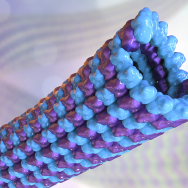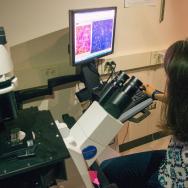On a rush-hour train or a crowded flight, you might draw your limbs in close, shrinking as people fill the space. As it turns out, living cells behave similarly in confinement, adjusting their size while growing alongside other cells in sheets of tissue.
John Devany, then a graduate student in the lab of biophysicist Margaret Gardel, had been studying epithelial monolayers—sheets of cells that form barriers in skin and coat internal organs—when he noticed something interesting about how the cells were dividing.
“The way people think about division is that a cell will grow to twice its size, divide, and repeat the cycle,” says Devany, the first author of the study, published in Developmental Cell. But in the epithelial tissue he was observing, division was proceeding as usual, but the daughter cells were ending up smaller than the mother. The team, collaborating with researchers from New York University, decided to investigate the mechanisms that control cell growth and cycle duration in tissue and discovered that the two processes are not directly coupled.
How cells proliferate—increase in size and number—while in contact with other cells is key to understanding tissue development and growth. A process called “contact inhibition” is thought to restrict cell growth when space becomes limited, controlling tissue overgrowth and preventing tumors, for instance. But the process is regulated by several pathways, and scientists don’t fully understand it.
Gardel, the Horace B. Horton Professor of Physics and Molecular Engineering, studies how living matter emerges from collections of molecules to control the physiology of cells and tissues. “How cells sense their mechanical environment is critical to stopping them from proliferating,” she says. “And how do the cells actually turn off their biomass production as they feel more constrained? We just don’t know.” But these results—that the growth pathway is distinct from the cell cycle pathway—help give researchers a framework to study the mechanisms.
Tight quarters
Many types of cells in our body aren’t packed shoulder to shoulder; they regulate their proliferation through chemical messaging, for instance, or through interactions with their extracellular environment. Epithelial cells form tight barriers, though, able to prevent ions from crossing, and must sense and react to close physical neighbors.
To explore and quantify how tissue growth dynamics regulate cell proliferation, the team used lab-grown layers of mammalian epithelial tissue and observed the cell growth as they went from separate colonies to a layer of merging colonies to tightly packed mature epithelial tissue.
The researchers found that as the tissue expanded and became confined by the size of the culture vessel, cell growth was suppressed, but cell cycle length leading to division was not directly affected. Yet, as the daughter cells became smaller and smaller in volume, they eventually reached a limit at which division did stop. “The size of organelles, including the nucleus, scale down with the cell’s overall volume,” says Gardel. But the genome size is fixed. “So that’s the limit to how small you can get”—just big enough that the DNA still fits inside.
However, the team found that overexpressing a protein called cyclin D1 allowed the cells to bypass that limit and become even smaller before division halted, indicating that the protein controls the volume-dependent checkpoint. When a cell becomes too small, its genome can get damaged, making those cells particularly prone to becoming cancerous, says Gardel. These findings suggest that cell-volume regulation is key to contact inhibition and the overall health of tissue.
Potential for cancer treatments
“Most of my lab has worked on questions of cellular scale biophysics,” says Gardel, toward an understanding of the machinery that drives cell behavior. “Our study shows the power of using biophysical and bioengineering approaches to develop new ways to understand tissue scale behaviors.”
“Understanding the mechanisms of growth and division regulation might eventually help develop cancer treatments,” adds Devany. For instance, is the cell volume of small cell cancers—such as some types of lung, prostate, and pancreatic tumors—contributing to new mutations? Maybe that could offer therapeutic targets, Devany suggests.
The dynamics of cells in confinement might also add to the field of tissue engineering, he says, to evolve bioprinting methods and develop material scaffolds that might one day surgically replace damaged tissues. “If we better understand how cells grow and divide in the context of tissue, it might help optimize these kinds of systems.”
How do they know that?
Now that Gardel’s team has determined that confined epithelial cells regulate their size and cell cycle separately, one of the next questions is: How do cells know they’re confined? And how do they sense how big they are at any given point?
The researchers were also surprised to find that the cells could communicate over long distances through tissue—some feeling constrained and then telling others to regulate their growth too. “We think the communication is probably mechanically based,” says Gardel, “but we’re trying to explain the origins of these interactions as well.”
UChicago associate professor of physics Arvind Murugan and a postdoc in his lab, Martin Falk, were co-authors on the paper, contributing their expertise on the theory of growth regulation. The University of Chicago Functional Genomics processed RNA sequencing samples.
Citation: “Epithelial tissue confinement inhibits cell growth and leads to volume-reducing divisions.” Devany J, Falk MJ, Holt LJ, Murugan A, Gardel ML. Dev Cell. June 14, 2023.
–This story originally appeared on the Physical Sciences Division website.

